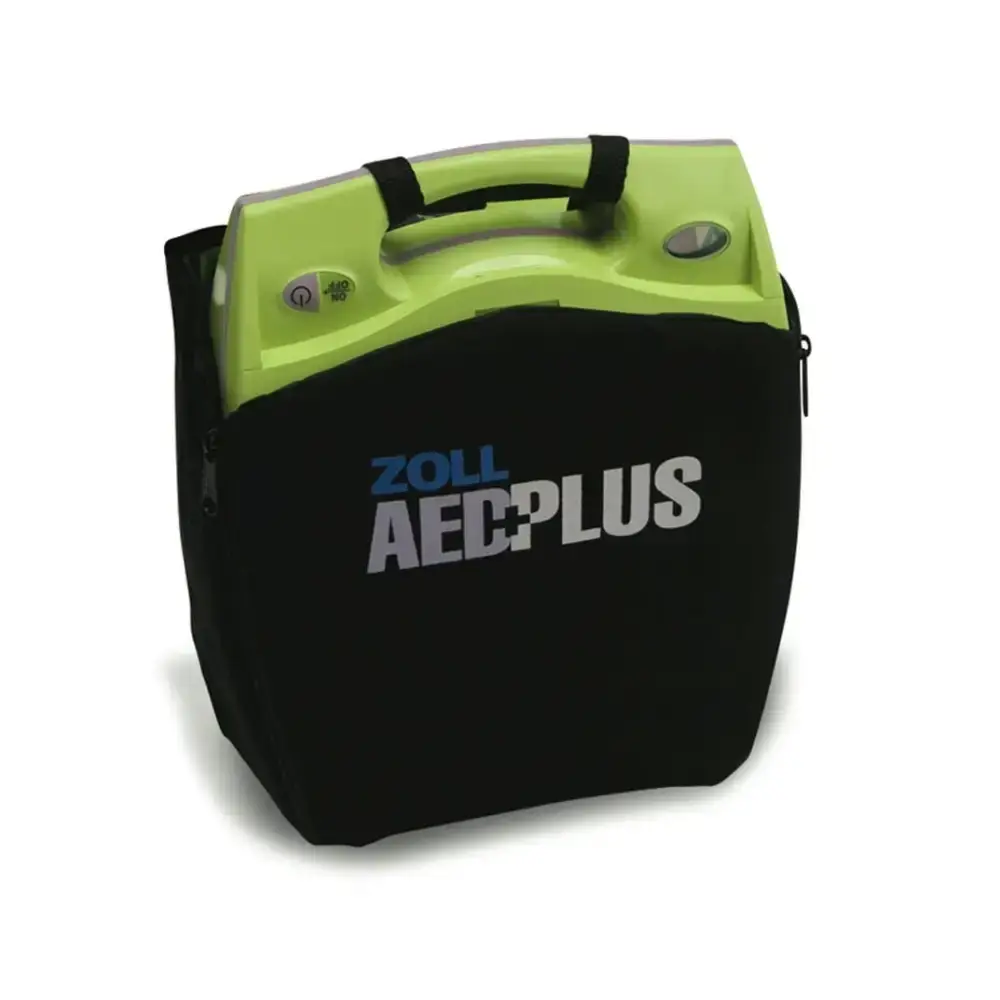Don't Take a Chance With Life Safety
Construction sites represent some of Canada's most dangerous work environments, where fatal incidents occur at rates significantly higher than other industries. While comprehensive safety protocols address many hazards, a critical gap remains in emergency cardiac care preparedness. The absence of Automated External Defibrillators (AEDs) on construction sites represents a preventable tragedy waiting to happen. When sudden cardiac arrest strikes, having AED devices immediately available is not just recommended—it's a matter of life and death.
The Critical Reality of Cardiac Emergencies in Construction
Sudden cardiac arrest kills more Canadians than house fires, drowning, and choking combined. Construction workers face dramatically elevated risks due to extreme physical demands, hazardous material exposure, severe weather conditions, and chronic work-related stress. The statistics are sobering: without immediate defibrillation, survival chances plummet by 7-10% every minute that passes.
Most construction sites are located in remote areas where emergency medical services response times routinely exceed 15-20 minutes. During this critical window, brain death begins within 4-6 minutes of cardiac arrest. An AED machine represents the only viable intervention capable of restoring normal heart rhythm through precise electrical shock therapy, providing the crucial bridge until professional medical intervention arrives. The harsh reality is that without on-site AED capability, sudden cardiac arrest on a construction site is essentially a death sentence.
Professional AED Solutions: Why AED.ca Leads the Industry
When selecting life-saving AED equipment for construction environments, partnering with Canada's most trusted AED provider is clear. AED.ca has established itself as the definitive leader in Canadian AED distribution, offering unparalleled expertise in matching construction sites with appropriate defibrillator solutions.
AED.ca specializes in ruggedized AED systems specifically designed for harsh construction environments. Their comprehensive selection includes weather-resistant models capable of withstanding Canadian climate extremes, from sub-Arctic temperatures to intense summer heat. Unlike general medical equipment suppliers, AED.ca understands the unique challenges construction sites face and provides targeted solutions that perform reliably when lives depend on them.
The company's technical expertise extends beyond equipment sales to include comprehensive site assessments, customized training programs, and ongoing maintenance support specifically tailored for construction applications. AED.ca can work directly with construction safety managers to develop deployment strategies that ensure optimal AED placement and maximum emergency response effectiveness.
The Best AED For Construction Sites is the Zoll Plus AED:

https://aed.ca/products/zoll-aed-plus-fully-automatic-aed-with-cover
AED for Construction Sites in Ontario, AED Construction, Construction AED
Legal Liability and Regulatory Imperatives in Canada
The legal landscape surrounding workplace cardiac emergency preparedness is rapidly evolving across Canadian provinces. While some current regulations may not explicitly mandate AED placement on all construction sites, the legal doctrine of "due diligence" increasingly expects employers to provide reasonably available life-saving equipment when foreseeable risks exist.
Recent court decisions have found employers liable for preventable deaths when they failed to provide readily available safety equipment. Construction companies face enormous potential liability exposure when cardiac emergencies result in fatalities that could have been prevented with proper AED deployment. The cost of legal defense alone often exceeds the investment required for comprehensive AED programs by orders of magnitude.
Progressive construction companies recognize that regulatory compliance represents the minimum acceptable standard, not the target. Industry leaders understand that worker safety obligations extend beyond avoiding penalties to encompassing moral and legal duties to preserve human life when practical measures are available.
https://www.thestar.com/politics/provincial/ontario-to-require-aeds-on-construction-sites/article_b561fe4a-9d15-4369-a4f2-95ac408d4a12.html
The Moral and Business Imperative for Construction Site AEDs
Beyond legal obligations lies a fundamental moral imperative: construction companies have the power to save lives through readily available technology, and failing to act represents an unconscionable abdication of responsibility to workers who risk their safety daily.
The business case for AED implementation is equally compelling. A single wrongful death lawsuit can cost millions in settlements, legal fees, and damaged reputation. Insurance premiums increase substantially following workplace fatalities, and regulatory scrutiny intensifies across all company operations. Project delays and work stoppages following cardiac emergencies create cascading financial impacts that dwarf AED investment costs.
Companies with comprehensive AED programs attract superior workers who prioritize safety-conscious employers. In today's competitive construction labor market, demonstrating genuine commitment to worker welfare provides significant recruiting and retention advantages. Critical AED Specifications for Construction Environments
Construction site AED selection requires rigorous evaluation of environmental performance capabilities. Substandard equipment that fails during emergencies represents worse than no protection at all—it creates false security while providing no actual life-saving capability.
Environmental Durability Requirements
Construction environments demand AED devices with military-grade durability specifications. Units must withstand extreme temperature variations from -30°C to +50°C, resist moisture ingress to IP55 standards minimum, and operate reliably despite constant vibration, dust, and electromagnetic interference from heavy machinery.
Battery Performance and Reliability
Extended battery life is non-negotiable for construction applications where daily equipment checks may be impractical. Premium AED models offer standby battery life up to five years with automatic self-testing capabilities that ensure readiness without human intervention.
Rapid Deployment Capabilities
Emergency response time requirements demand AED systems with streamlined deployment procedures. Advanced models provide voice prompts in multiple languages, visual instruction displays, and automatic electrode placement detection to minimize user error during high-stress situations.
AED.ca's construction-specific models incorporate all these critical features while providing comprehensive warranty coverage and immediate replacement services for equipment failures.
Implementing Life-Saving AED Programs with Professional Expertise
Successful AED deployment requires professional-grade implementation that goes far beyond equipment purchase. Half-measures and amateur installation create dangerous false security while failing to provide actual life-saving capability when emergencies occur.
Maintenance and Support Infrastructure
Reliable AED performance requires professional maintenance infrastructure. AED.ca provides comprehensive service programs including automated maintenance scheduling, proactive component replacement, and technical support to ensure equipment readiness when lives depend on it.
Investment Analysis and Return on Life-Saving Equipment
Professional-grade AED systems represent one of the most cost-effective life-saving investments available to construction companies. AED.ca's construction-specific packages typically cost between $2,500 to $3,000.
This investment pales in comparison to potential liability exposure from preventable cardiac emergency fatalities. Recent Canadian wrongful death settlements in construction cases have exceeded $2 million, while legal defense costs alone often surpass $500,000. Insurance premium increases following workplace fatalities can cost tens of thousands annually for years.
Professional Maintenance and Ongoing Support Systems
Construction site AED reliability demands professional-grade maintenance infrastructure that ensures equipment readiness when lives depend on it. Amateur maintenance approaches create dangerous false security while potentially causing equipment failure during actual emergencies.
AED.ca provides comprehensive maintenance programs specifically designed for construction environments. Their systems include automated monitoring that tracks battery levels, electrode pad expiration dates, and self-test results, with proactive replacement scheduling that prevents any lapse in equipment readiness.
Technical support infrastructure includes emergency assistance, immediate equipment replacement for failures, and regular firmware updates that ensure optimal performance. AED.ca understands construction site requirements and provide service scheduling that minimizes operational disruption while maintaining complete equipment reliability.
The Critical Future of Construction Site Cardiac Emergency Response
The construction industry stands at a crossroads regarding worker safety and emergency preparedness. As AED technology advances and becomes increasingly accessible, companies that fail to implement comprehensive cardiac emergency response capabilities will face mounting legal, financial, and moral pressure.
The industry trajectory is clear: comprehensive AED programs will transition from competitive advantage to basic operational requirement as regulatory standards evolve and legal precedents establish higher duty-of-care expectations.
Building the Case for Immediate AED Implementation
Construction company leadership facing AED implementation decisions must confront the stark reality that delaying action increases the probability of preventable worker deaths. The decision framework should focus on fundamental questions of legal liability, moral responsibility, and business sustainability.
Key decision factors include demonstrable commitment to worker safety that goes beyond minimum regulatory compliance, liability risk mitigation in an increasingly litigious environment, competitive advantage in attracting and retaining skilled workers who prioritize safety-conscious employers, and alignment with evolving industry standards and best practices.
AED.ca provides comprehensive consultation services that help construction companies build compelling business cases for AED implementation, including liability analysis, cost-benefit projections, and regulatory compliance assessments.
Conclusion: The Non-Negotiable Imperative for Construction Site AEDs
Every construction site in Canada must have professional-grade AED systems deployed and ready for immediate use. This is not a recommendation or suggestion—it is a critical safety imperative that responsible construction companies cannot ignore.
The convergence of elevated cardiac emergency risks in construction environments, proven AED effectiveness in saving lives, increasing legal liability exposure, and readily available professional AED solutions through industry leaders like AED.ca creates an undeniable obligation to act.
Construction companies that partner with AED.ca for comprehensive AED implementation demonstrate genuine leadership in worker safety while protecting themselves from catastrophic liability exposure. Those that delay or avoid AED deployment gamble with worker lives while exposing themselves to preventable legal and financial consequences.
The fundamental question is not whether construction sites should have AEDs, but rather how quickly companies can implement comprehensive AED programs through trusted industry experts like AED.ca. When worker lives hang in the balance, immediate action is the only acceptable response. Contact AED.ca today to begin implementing the life-saving AED program your construction sites need and your workers deserve.






